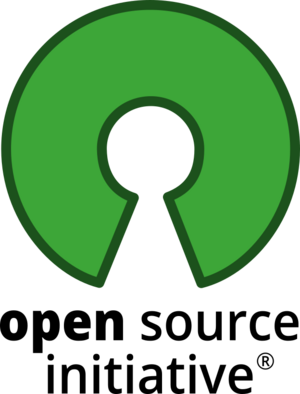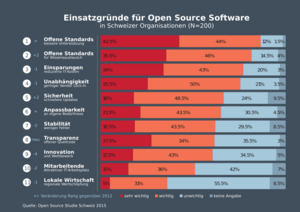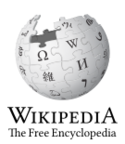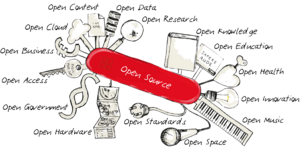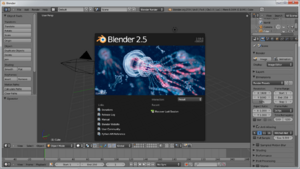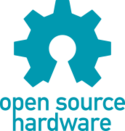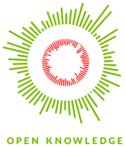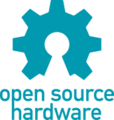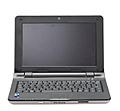Open source facts for kids
Open source means that something, like computer code, is made available for everyone to see, use, change, and share. Think of it like a recipe that anyone can use, tweak, and give to others. The open-source model is a way of working where many people team up to create something, sharing their ideas and work freely.
A big idea behind open source is peer production. This means people work together, and the results – like code, designs, or instructions – are free for everyone. The idea of open source first became popular with computer software. It was a way to offer an alternative to "proprietary" software, which keeps its code secret. Today, the open-source model is used for many things, like creating helpful technology for communities or even finding new medicines.
Open source encourages everyone to have access to a product's design or plan, usually through a special "open-source license." This license lets people freely share and change the design. Before the term "open source" became popular, people used different words. But with the rise of the Internet, "open source" really took off. The open-source software movement helped make rules clearer about things like copyright and how to use these shared creations.
When we talk about open source, we often mean computer programs where the source code (the instructions that make the program work) is open to everyone. This code is released under a software license. Depending on the license, others can download it, change it, and even share their new version with the community. Many big groups, like the Apache Software Foundation, support open-source projects. For example, they support Apache Hadoop and the Apache HTTP Server, which are both open-source.
Contents
The History of Open Source
Sharing technical information isn't new; it happened long before the Internet! For example, in the early days of cars, a group controlled a patent for a gasoline engine. This allowed them to control the car industry.
But in 1911, Henry Ford, who made cars, won a challenge against this patent. After that, the patent became almost useless. A new group was formed, which later became the Motor Vehicle Manufacturers Association. This group made an agreement: even though each company would create new technology and get patents, these patents would be shared openly among all car makers without money changing hands. By the time World War II started, hundreds of patents were being shared this way, with no lawsuits or payments.
Early examples of sharing computer code include IBM's releases of its operating systems in the 1950s and 60s. Also, a group called SHARE was created to help people exchange software. In the 1960s, researchers working on the ARPANET (which led to the Internet) used an open process called "Request for Comments" (RFC). This encouraged people to give feedback on early network designs, leading to the birth of the Internet in 1969.
Sharing source code on the Internet started when the Internet was very basic. Software was shared using tools like Usenet and IRC. For example, BSD and Linux were widely shared and discussed on Usenet.
How the Term "Open Source" Began
The term "open source" appeared in the late 1990s. Some people in the free software movement felt that the term "free software" was confusing. They wanted a new term that sounded more friendly to businesses. The word "free" in "free software" could mean "no cost," but it actually meant "freedom."
A group of people, including Christine Peterson and Eric S. Raymond, suggested "open source." This happened after Netscape announced in January 1998 that it would release the code for its web browser, Netscape Navigator. Linus Torvalds, who created Linux, supported the new term. However, Richard Stallman, who started the free software movement, decided not to use it. Netscape later released its code under the Mozilla Public License.
Eric Raymond worked hard to make the new term popular. He asked the free software community to adopt it in February 1998. Soon after, he and Bruce Perens started The Open Source Initiative (OSI).
The term became even more known after an event in April 1998, organized by publisher Tim O'Reilly. This event, first called the "Freeware Summit" and later the "Open Source Summit," brought together leaders of many important free and open-source projects. They discussed alternatives to "free software." After a vote, "open source" was chosen and announced to the public.
The Economics of Open Source
Some experts see open source as a "knowledge good." Creating the original work takes a lot of time, money, and effort. But making copies of it costs very little. This is called the "marginal cost."
Normally, copyright laws create a kind of monopoly. This means the creator can charge a high price for copies, much more than the cost of making each copy. This helps the creator get back the money they spent making the original work. But copyright can also make it harder for people to access the work or create new versions of it.
Open source helps by reducing these access costs. It's like a "consumers' cooperative" where people work together. Basic economic ideas suggest that lower costs lead to more use and more new creations. Groups like Creative Commons offer special licenses that let creators choose how much to restrict their work. These choices help society avoid the costs of policing copyright rules.
Some people worry that if consumers don't pay for copies, creators won't make enough money to create new things. They argue that this could mean fewer goods are available. In reality, creators can choose if they want to use a proprietary license (and charge money) or an open license. For example, the pharmaceutical industry mostly uses patents to protect its inventions, so medicines are usually proprietary. However, more and more, new technologies are being developed using open-source ideas.
There's a lot of proof that open-source development creates huge value. For instance, with open-source hardware, digital designs are shared for free. Anyone with a 3D printer can make the product for just the cost of materials. The original creator can then get feedback and improvements from the community.
Many open-source projects are very valuable. Here are the top ten most important open-source projects based on their economic impact:
| Ranking | Project | Leading company | Market value |
|---|---|---|---|
| 1 | Linux | Red Hat | $16 billion |
| 2 | Git | GitHub | $2 billion |
| 3 | MySQL | Oracle | $1.87 billion |
| 4 | Node.js | NodeSource | ? |
| 5 | Docker | Docker | $1 billion |
| 6 | Hadoop | Cloudera | $3 billion |
| 7 | Elasticsearch | Elastic | $700 million |
| 8 | Spark | Databricks | $513 million |
| 9 | MongoDB | MongoDB | $1.57 billion |
| 10 | Selenium | Sauce Labs | $470 million |
This ranking looks at how active projects are in online discussions, on GitHub, in search engines, and their influence on jobs.
There are other ways to create things without needing a traditional license:
- Creating for Fun: People like Wikipedia editors add content just for enjoyment. Artists love to create. Both groups benefit from free starting materials.
- Donations: Some creators ask for donations after their work is used, like street performers or public TV stations.
- Supporters: For example, open-access publishing is often funded by universities or governments. Researchers also want to publish to gain a good reputation.
- Free Basic, Paid Premium: Some offer a limited version of their product for free and charge for a full, "premium" version.
- Free Product, Paid Services: Give away the product but charge for support, like with open-source business software. Or give away music but charge for concert tickets.
- Gaining Market Share: Companies might give away a product to get more users, like in the "browser wars" or with the Android operating system.
- For Personal Use: Businesses or developers often create software to solve their own problems. They might then make it open source, benefiting from others' improvements. This spreads the work of maintaining the software among more users.
Open Collaboration
The open-source model encourages open collaboration. This means many people work together, often without strict rules, to create something valuable. They make it available to everyone, whether they helped or not. A key part of open-source software development is peer production, where things like code and designs are free for all. This way of working started because of the limits of secret, "proprietary" code. It's now used in projects like open-source appropriate technology and even in finding new medicines.
The open-source idea for software has inspired other types of open collaboration. You can see it in Internet forums, email lists, and online communities. It's also the main idea behind projects like TEDx and Wikipedia.
Open collaboration is the principle behind peer production, mass collaboration, and wikinomics. It was first seen in open-source software but is now in many other areas, like Creative Commons content. It also helps explain crowdsourcing and open innovation.
Experts define open collaboration as working together based on three ideas:
- Egalitarianism: Everyone can join, and there are no unfair barriers.
- Meritocracy: Decisions and status are based on good ideas, not on who you are.
- Self-organization: Processes change to fit the people, not the other way around.
In all these examples of open collaboration, anyone can help, and anyone can freely use what's created. People work together, often loosely, to make something valuable.
There's an annual conference called the International Symposium on Wikis and Open Collaboration (OpenSym). It defines open collaboration as "collaboration that is egalitarian, meritocratic, and self-organizing."
Open-Source Licenses
Open source promotes open access to a product's design or plan, usually through an open-source license or free license. This license also allows for the free sharing of that design. The term "open source" became popular partly because of the Internet. The open-source software movement helped clarify rules about copyright and how to use these shared creations.
An open-source license is a type of license for computer software and other products. It lets people use, change, or share the code, blueprint, or design under certain rules. This means users and companies can look at and change the code for their own needs, curiosity, or to fix problems. Most open-source software is available for free, but not always. Licenses that only allow non-commercial use or personal changes are usually not considered open-source.
However, open-source licenses can have some rules. For example, they might require you to keep the original authors' names or to share your modified version under the same license (this is called a copyleft license). A popular set of open-source software licenses are those approved by the Open Source Initiative (OSI), based on their Open Source Definition (OSD).
Applications of Open Source
The idea of open source has influenced social and political views. People who support open source in one area often want to see it used in others. However, some founders of the open-source movement, like Eric S. Raymond, have warned against applying it too broadly. They say strong arguments for open software shouldn't be weakened by trying to apply it where it might not fit as well. The full impact of the open-source movement is still developing.
The open-source movement has also led to more transparency and freedom in areas like biotechnology research. Even the ways research is done can benefit from open-source ideas. It has also led to the fast-growing open-source hardware movement.
Computer Software
Open-source software is software where the code is published and available to everyone. This means anyone can copy, change, and share the code without paying fees.
Examples include LibreOffice and the GNU Image Manipulation Program. Just like with other software, users must agree to a license. But open-source licenses are very different from "proprietary" ones.
Open-source code can grow and improve through teamwork. These teams include individual programmers and large companies. Some programmers who start an open-source project might even create companies that offer products or services using open-source programs. Here are some examples of open-source software:
- Linux (which runs many of the world's servers)
- MediaWiki (the software Wikipedia uses)
- Many more, like those found in the List of free and open-source software packages.
The Google Summer of Code (GSoC) is a yearly program where Google pays students to work on open-source coding projects during the summer. It's a big project, with many organizations participating.
Electronics
Open-source hardware is hardware whose initial design, often in a software format, is published and available to everyone. This lets anyone copy, change, and share the hardware and its code without paying fees. Open-source hardware also improves through community teamwork. These communities include individual developers, hobbyists, and large companies. Examples include:
- Openmoko: a family of open-source mobile phones, including their design and operating system.
- Arduino: a popular microcontroller platform for hobbyists, artists, and designers.
- Open Compute Project: designs for computer data centers, including power supplies and motherboards.
Food and Beverages
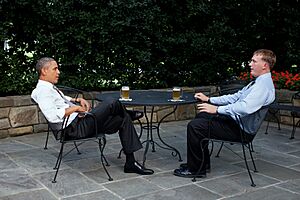
Some people argue that data from food science and cooking studies should be freely available to help with reproducibility (meaning others can repeat the experiments). Many people have also published recipe books using Creative Commons licenses.
- Open-source colas: These are soft drinks, like Coca-Cola or Pepsi, whose recipes are open source and developed by volunteers. The taste is said to be similar to standard sodas. Most big drink companies keep their recipes secret.
- Free Beer: This is an open-source beer created by students in Copenhagen to show how open-source ideas could be used outside of computers.
Digital Content
- Wikimedia Foundation Projects: Websites like Wikipedia and Wiktionary use Creative Commons content licenses. These licenses are designed to be similar to open-source software licenses. They help ensure that content remains free to use, that original documents are available, and that changes are easily accepted. Other important sites with open-source-like ideals are Project Gutenberg and Wikisource. They post many books whose copyright has ended, making them free for everyone.
- Google Sketchup's 3D Warehouse: This is an open-source design community that uses free software.
Science and Engineering
- Research: The Science Commons was created to help reduce the high legal costs of sharing and reusing scientific work from journals.
- Engineering: Hyperloop, a proposed high-speed transport system by Elon Musk, is described as an "elevated, reduced-pressure tube that contains pressurized capsules."
- Construction: WikiHouse is an open-source project for designing and building houses.
Robotics
An open-source robot is a robot whose designs, plans, or code are released under an open-source model.
"Open" vs. "Free" vs. "Free and Open"
Free and open-source software (FOSS) or free/libre and open-source software (FLOSS) refers to code that is openly shared and licensed without limits on how it's used, changed, or shared. There's often confusion because "free" (also called "libre") means freedom, not "no cost." Think of "free speech" not "free beer."
On the other hand, Richard Stallman argues that "open source" simply means the code is public and can be looked at, but doesn't necessarily grant other rights. However, those who support the term "open source" say that the conditions in the Open Source Definition must be met.
"Free and open" should not be confused with things like government ownership or anti-corporate activism.
- GNU
- Gratis versus libre (no cost vs. no restriction)
Open Source in Society
The rise of open-source culture in the 20th century came from a conflict. On one side, creative people needed to use content that was often copyrighted. On the other side, strict intellectual property laws made it hard to access copyrighted material. Copyright terms became longer, and laws like the Digital Millennium Copyright Act (DMCA) made it harder to get around anti-piracy technologies.
Even though artistic use is often allowed under "fair use" rules, these rules are complicated. This makes artists and creators uncertain. Also, copyright owners' protective actions can create a "chilling effect," making creators afraid to use existing works.
The idea of an "open-source" culture is similar to "Free Culture" but also different. "Free culture" comes from the free software movement. But supporters of open-source culture believe some intellectual property law is needed to protect creators. They suggest a more balanced approach than what big companies usually want.
Websites like ccMixter offer free space for anyone willing to license their work under a Creative Commons license. The creations are then free to download for anyone with Internet access. Older technologies like telephones or televisions limited how users could interact.
With technologies like peer-to-peer networks and blogs, creators can use huge social networks to share their work. Unlike traditional media, sharing digital media on the Internet can cost almost nothing. Tools like BitTorrent and Gnutella try to make file sharing completely decentralized.
Government and Politics
- Open politics (or Open-source politics) uses Internet tools like blogs and email to get quick feedback between political groups and their supporters. Another idea of Open-source politics is developing public policy using rules similar to open-source software.
- Open-source governance is like open-source politics but focuses more on democracy and promoting freedom of information.
- Open-source political campaigns refer specifically to political campaigns.
- The South Korean government wants to use more free and open-source software to rely less on proprietary (secret) software. They plan to require open standards, so the government can choose from many operating systems and web browsers.
Ethics
Open-source ethics has two main parts:
- Open-source ethics as a way of thinking: Researchers like Charles Ess and David Berry explore if ethics can learn from an open-source approach.
- Open-source ethics as professional rules: This focuses on ethics and professionalism in the computer industry, especially in software development.
Media
Open-source journalism used to mean standard news gathering and fact-checking, similar to how military intelligence uses "open-source intelligence." Now, open-source journalism usually means new ways of publishing online, often with content created by users, rather than just by professional journalists. TIME magazine once called this "user created content."
Weblogs, or blogs, are another important platform for open-source culture. Blogs are websites with regular posts, shown in reverse order. They use technology that makes it easy to update pages without knowing much about design or code. While companies and political campaigns use blogs to share information, many individuals use them for personal expression, organizing, and socializing. Some blog platforms, like LiveJournal or WordPress, use open-source software that anyone can change. This makes blogs a flexible tool for people to borrow and share culture.
Messageboards are also platforms for open-source culture. These are online places where people with similar interests can gather and post messages. Messageboards sometimes have moderators who make sure people follow rules. Other features include private messages and chat. Some messageboards use phpBB, which is a free open-source program. While blogs are more about individual expression, messageboards are about creating conversations where information can be shared freely and quickly. They help remove "middlemen" from everyday life. For example, instead of relying on ads, you can ask other users for honest reviews of a product.
OpenDocument is an open document file format for saving and sharing editable office documents like reports, spreadsheets, and presentations. Organizations and people who store their data in an open format like OpenDocument avoid being stuck with one software company. This means they are free to switch software if their current provider goes out of business or changes its prices.
Open-source movie production can mean a few things: a system where a changing crew and cast work together, a system where the movie is made available for others to reuse, or a system where only open-source tools are used to make the film. The 2006 movie Elephants Dream is known as the "world's first open movie" because it was made entirely with open-source technology.
An open-source documentary film allows people to contribute old footage and other film parts, both unedited and edited. This way, online contributors become part of making the film, helping to shape its story and visuals. The first open-source documentary film is WBCN and the American Revolution, which started in 2006.
Open-source film-making can also mean taking ideas from open-source software, but for filmmakers, the "source" is raw, unedited footage. It can also mean a way of making films where the creation process is "open," with many different people contributing at different times.
Open-IPTV is IPTV (Internet Protocol Television) that isn't limited to one studio or cast. It uses the Internet to bring together efforts and resources to create an online community where everyone contributes to a show.
Education
In schools and universities, there's a discussion about making more "intellectual commons" (like Creative Commons). Supporters point to projects like the Connexions Project at Rice University, OpenCourseWare at MIT, Salman Khan's Khan Academy, and Wikipedia as examples of open source in education.
Open-source curricula are teaching materials whose digital source can be freely used, shared, and changed. Another area in education is research. Many funded research projects create software. Because sharing software openly is good for science, there's growing interest in making research software available under an open-source license. In the UK, the Joint Information Systems Committee (JISC) has a policy on open-source software and offers advice to schools and universities.
In 2010, President Barack Obama signed a law that included $2 billion to fund the TAACCCT program. This is described as the "largest OER (open education resources) initiative in the world." It focuses on creating teaching materials with industries for jobs in areas like manufacturing, health, and IT.
Innovation Communities
The idea of sharing is older than the open-source movement. For example, scientists have freely shared information since at least the 1800s. Open-source principles have always been part of science. The sociologist Robert K. Merton described four main parts of the scientific community: universalism (an international view), communalism (sharing information), objectivity (keeping personal views out of research), and organized skepticism (requiring proof and review).
These ideas are partly supported by US law, which protects expression and methods but not the ideas themselves. There's also a tradition of publishing research results to the scientific community instead of keeping all knowledge secret. A recent effort in scientific publishing is open access, which means research should be free and available to the public. Many open-access journals now exist online, though most journals still charge fees. The Budapest Open Access Initiative is an international effort to make all research articles free on the Internet.
The National Institutes of Health (NIH) recently suggested a policy to make NIH-funded research results freely available to the public and other international groups six months after they are first published. This is important because a lot of scientific research is publicly funded. Questions remain about balancing profit with public access and ensuring standards don't drop with a shift to open access.
Benjamin Franklin was an early contributor, giving all his inventions, like the Franklin stove and bifocals, to the public. New non-profit groups are also using open-source technology. For example, the Open Source Youth Network started in 2007. Open innovation is another new idea that suggests putting research and development into a common pool. The Eclipse platform is an example of an open innovation network.
Arts and Recreation
Copyright protection is used in performing arts and even sports. Some groups have tried to remove copyright from these activities.
In 2012, Russian music composer Victor Argonov released the detailed files of his electronic opera "2032" under a free license. He said he did this to support global actions against strict online piracy laws. Some Internet sources called "2032" the first open-source musical opera.
Images for kids


